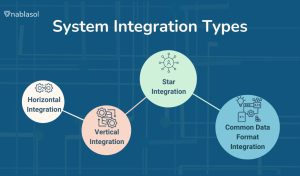The capacity to successfully integrate many technological systems has become essential in today’s business environment. Combining several subsystems or aspects into an overall structure is called system integration. It has become more important as organizations try to develop, improve efficiency, and streamline their operations.
The process of physically and functionally integrating many hardware and software applications to operate as a single. This cohesive system is the integration of a system. To make hardware, software, and network infrastructure operate flawlessly together, integration is required.
System Integration’s Significance
The power of integration to dismantle organizational barriers and promote better departmental collaboration. Also, data flow is the reason it’s so important. It helps companies make the most of breakthroughs while utilizing their current technologies, resulting in a more responsive and flexible operational framework.
What are the Types of Integration?
There are various forms of system integration, each addressing unique goals and obstacles. These include:

- Horizontal Integration: Also referred to as “enterprise service bus” (ESB), the approach entails connecting various apps and systems via a shared middleware layer to promote data interchange and communication.
- Vertical Integration: This technique creates an organizational structure where each functional layer connects with the layer above or below it by integrating systems according to their functionality.
- Star Integration: Also referred to as “spaghetti integration,” this method involves connecting each device to every other system directly, creating a complicated web of connections.
- Common Data Format Integration: This kind of integration allows easy data interchange and communication by transforming data from several systems into a single format.
What are the Advantages of Integrating Systems?
There are several benefits that software integration provides to companies, such as:
Enhanced Efficiency: Integrating the system lowers labor expenses and employee turnover by automating operations and facilitating smooth data flow.
Improved Decision-Making: Businesses need to access more real-time information and connect with systems to make more informed decisions.
Scalability: Integration enables firms to add or modify systems as their operations expand. It also assures long-term scalability
Enhanced Flexibility: When they integrate disparate systems, businesses are better equipped to respond swiftly to shifts in the market and technological innovations.
Important System Integration Elements
Some essential elements that are needed for successful software integration:
Middleware for integration: This program serves as a link between several systems. Also facilitating data interchange and communication.
APIs (Application Programming Interfaces): APIs enable software applications to communicate and facilitate integration.
Data Integration Tools: Data integration technologies help in data extraction, transformation, and loading from several sources into a single format.
Integration testing definition: This entails thorough testing to guarantee that the integrated system satisfies the requirements and operates as intended.
Integration Diagram: An integration diagram illustrates the connections between various systems and parts inside an integrated framework.
What are The Services and Solutions for System integration?
To handle the complexity of system integration software, firms frequently turn to professional integrated system solutions and services. These consist of integration consultants who offer knowledgeable guidance on integration techniques, software integration services provided by IT consulting businesses, and integrating software that offers a platform for merging several systems.
- Integration software: This offers tools and capabilities for connecting and managing various systems to facilitate the integration process. It is essential for a seamless and effective integration process.
- Integration Testing Definition: Testing is a crucial component of software integration. It helps to ensure the integrated system satisfies all criteria and functions as intended. It includes recognizing any issues that need to be fixed and verifying that the parts are compatible with one another.
- System integration engineer: Integration engineers are experts in the planning, execution, and administration of integrated systems. They are essential in making sure that the integration process is completed successfully and that the finished system functions without a hitch.
- Integration Diagram: An integration diagram shows the connections between various systems and components visually. It allows for comprehending the integrated system’s architecture and locating possible areas for development.

- System Integrations Inc.: Organizations such as System Integrations Inc. are experts in offering complete integration services. They also assist companies in achieving operational excellence and the seamless integration of their technological systems.
- Integrated Test Systems: Systems called integrated test systems are made to make it easier to test integrated systems. It also makes sure they satisfy the necessary reliability and performance requirements.
- Integrating System Solutions: These are services and equipment packages intended to assist companies in efficiently integrating their systems. They consist of software, testing, and consulting services.
- Integration Services: These services provide knowledge and assistance in merging different technologies and systems.
- Consultant for Software Integration: A consultant for the integration of a system offers professional counsel. They also provide direction regarding the most effective methods and approaches for integrating systems. They support companies in navigating the integration challenges and guarantee a favorable result.
Conclusion
Integrating systems is an essential tactic for companies to maintain their competitiveness in today’s rapidly evolving digital market. Businesses can gain more flexibility and better decision-making. It can also increase efficiency by integrating diverse systems and technology. Businesses can guarantee a successful integration process in several ways. It includes using integration software, enlisting the help of software integration engineers, or consulting system integration consultants.
Software integration is becoming more and more important as the digital landscape changes. Businesses that can successfully integrate their systems will be in a better position. It will respond to changes in the market, adjust to new technology, and satisfy the changing needs of its clients. So, integrating a system is more than just a technical procedure. It’s a strategic necessity for companies hoping to prosper in the digital era.
Lastly, integration is an essential part of contemporary company strategy. Organizations may build a cohesive, effective, flexible technological infrastructure supporting their objectives. They propel their success by utilizing integration services and solutions. The ability to connect technologies efficiently will continue to be a critical distinction for businesses. Which will help them stay ahead in the cutthroat business world as the digital landscape changes.



